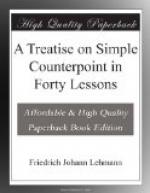The third may be omitted (b), or doubled (c), on the weak beat in this and succeeding species. [Fig. 95.]
[Illustration: Fig. 95.]
The minor or diminished seventh may be approached by a skip in an upward direction on the weak beat in any part. This usually necessitates the omission of some other chord-member on the weak beat.
The major or minor ninth may also be used in the same way, except in the lowest part, provided it is at least a ninth above the root. [Fig. 96.]
[Illustration: Fig. 96.]
The progression from vii_6 deg. to V in root-position or any inversion in the same measure, is good. [Fig. 97.] Use b and c only when using other than first species in two or more parts.
[Illustration: Fig. 97.]
Each measure should usually contain a complete chord. If not complete on the first beat, bring the missing interval in on the second. [Fig. 98.]
[Illustration: Fig. 98.]
The cadences in Fig. 99 are good, and will suggest others. The use of the fourth species is permitted as at a. A note may be repeated in the final cadence in all species as at b.
[Illustration: Fig. 99.]
EXERCISES
To cantus firmus a write the first species in all parts, as previously directed.
To cantus firmus b write second species in one part. Write three times, changing cantus firmus and counterpoint about so that they will appear in each part in turn.
CANTI FIRMI
[Illustration: Fig. 100.]
LESSON XIII
SECOND SPECIES IN TWO PARTS
[Illustration: Fig. 101.]
The suggestions for second species in both parts, in two-part counterpoint, apply for the two parts having the second species in three-part counterpoint.
Accidental harmonies sometimes appear on the weak beat. All tones in this accidental harmony foreign to the chord on the strong beat must be treated as dissonances. This must be regarded whenever two or more parts have other than the first species. [Fig. 102.]
[Illustration: Fig. 102.]
At Fig. 102_a_, the accidental harmony f-a-c is on the weak beat. The f and a, being foreign to the chord c-e-g on the strong beat, are correctly treated as dissonances. At b, the f and a are left by skip, which is not permitted.
The second species may be written continuously in all parts; the tones appearing on the weak beat must be harmonically related to one another, and those foreign to the chord on the strong beat must be treated as dissonances. [Fig. 103.]
[Illustration: Fig. 103.]
The first and second species may be mixed, as in Fig. 104.




